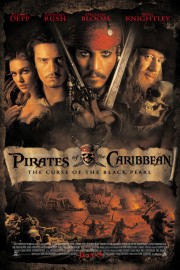Pirates of the Caribbean: The Curse of the Black Pearl
Okay, let’s be honest– how many people really saw this adaptation of the Disney theme park ride being the opening salvo of a multi-billion dollar franchise? I know I didn’t. So you can imagine my surprise when my mother and I watched the film on opening weekend, and like most everyone else, had fallen in love with Gore Verbinski’s sea-faring adventure, and the performance by Johnny Depp as Captain Jack Sparrow that launched the character actor into superstardom.
Two sequels and billions of dollars later, “The Curse of the Black Pearl” remains the high point of the “Pirates” franchise brought to us by Disney’s mega-producer Jerry Bruckheimer and director Verbinski, who prior to the “Pirates” films was best known for the subversive family film “Mouse Hunt,” the quirky Brad Pitt-Julia Roberts film “The Mexican,” and the hit J-horror remake “The Ring.” Since the “Pirates” franchise began, Verbinski continued his string of offbeat and original films with the 2005 Nicolas Cage dramedy “The Weather Man” and this year’s brilliant animated hit “Rango” (which reunited Verbinski with Depp); hopefully, Verbinski will find the same success he did with the “Pirates” films one day without needing to collaborate with Bruckheimer, although the way “Black Pearl” came out, maybe it wouldn’t be so bad.
So what made “The Curse of the Black Pearl” both a creative and financial success where other films– be it theme park adaptations like “The Haunted Mansion” or the 1995 pirate debacle “Cutthroat Island” –had failed? Call it a lucky convergence of events: Verbinski had just directed a hit with “The Ring”; the screenplay by Ted Elliott and Terry Rossio, working from a story they had concocted with Stuart Beattie and Jay Wolpert, captured the same sly sense of wit and adventure the writers achieved with their Disney-skewering “Shrek”; young actors Orlando Bloom and Keira Knightley had just become stars on the rise courtesy “The Lord of the Rings” trilogy and the indie hit “Bend It Like Beckham,” respectfully. And then there’s Depp, who brought his typical iconoclasm to the creation and performance of Jack Sparrow in ways that worried the studio, but sold Verbinski and Bruckheimer on the possibilities of what could be at the box-office, and audiences caught on.
The film starts with a dream of young Elizabeth Swan, who was with her father (Jonathan Pryce) on the day they came across a young man in the wreckage of a ship destroyed by the Black Pearl, a legendary pirate ship. The young man is one Will Turner, who had around his neck a gold coin that Elizabeth took from him so that young Will would not be sent to the galleys. As she wakes, we see Elizabeth as a young woman (played by Knightley) on the day one Captain Norrington (Jack Davenport) is to be promoted to Commodore. Her father has a dress for her to wear for the ceremony, in hopes that she will agree the Norrington’s plans to ask for her hand in marriage, although it’s obvious in seeing her with Will (now played by Bloom) that her feelings lie elsewhere. It’s on this day that Captain Jack sails into port and causes all sort of mayhem, but it’ll seem like child’s play when the Pearl comes to town, and takes Elizabeth captive, assuming her to be the offspring of one “Bootstrap” Bill who was last seen with a certain gold coin in his possession that the Pearl’s captain, Barbossa (Geoffrey Rush).
Compared to the bloated running times and increasingly complex plotting of “Dead Man’s Chest” and “At World’s End,” the 143 minutes of “Curse of the Black Pearl” seems lean and taut. Part of that is because Elliott, Rossio, and Verbinski understood in this film that a story can be long-winded but still wildly entertaining if the filmmakers in charge know the most important elements of the story being told. They lost that understanding a bit in the sequels, but most filmmakers do when they reverse engineer a franchise out of a blockbuster, and make a trilogy with films two and three back-to-back; just ask Robert Zemeckis (the “Back to the Future” trilogy) and the Wachowski Sisters (the “Matrix” trilogy), who had difficulty with it as well.
All that being said, “The Curse of the Black Pearl” remains one of the great blockbusters of the new century. Verbinski and cinematographer Dariusz Wolski bring this world to life with rich visuals, exciting action (be it hand-to-hand or the traditional swashbuckler battles at sea) and atmosphere, which shouldn’t be too surprising given Wolski shot instant classics “The Crow” and “Dark City,” among others. The visual effects that help bring to life the cursed crew of the Pearl, who are revealed as the undead in the moonlight, are some of the best Industrial Light & Magic have delivered in years. And the music by Klaus Badelt, who would hand off the reins to musical mentor Hans Zimmer for the sequels (including this weekend’s “On Stranger Tides,” with Rob Marshall directing), is a modern take on the traditional action adventure music one heard in the classics like “The Adventures of Robin Hood” that ratchets up the volume but is not lacking of the excitement and ability to rouse a viewer’s emotions to the story onscreen. In the end, however, it always comes down to the characters, and “The Curse of the Black Pearl” has plenty of memorable ones, be it minor comic relief (on both the pirate and British side) or more considered supporting characters (like Pryce’s father and Davenport’s Norrington), main villains (such as Rush’s wicked Barbossa) or dashing heroes (like Bloom’s Turner), ravishing damsels (Knightley’s Elizabeth) or off-kilter game changers (like Depp’s goofy and sensational Captain Jack). No wonder audiences wanted more. Of course, given how that turned out creatively, one wonders if audiences weren’t a little rum drunk.










